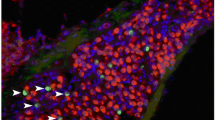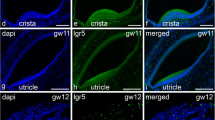Summary
The distribution of protein gene product (PGP) 9.5 was analyzed in the human fetal cochlea using the indirect immunofluorescence method. In the 12- and 14-week-old human fetuses, the cells of the greater epithelial ridge and the lesser epithelial ridge were overall labelled with PGP 9.5, while the stria vascularis and the Reissner's membrane did not exhibit any staining. Spiral ganglion cells and cochlear nerve fibers were labelled with PGP 9.5 and PGP 9.5-positive nerve fibers made contact with the basement membrane of the Corti primordium in the 12-week-old human fetus. These results suggest that PGP 9.5 might be used as a histological marker of maturation and innervation in the human cochlea.
Similar content being viewed by others
References
Dechesne CJ, Pujol R (1986) Neuron-specific enolase immunoreactivity in the developing mouse cochlea. Hear Res 21:87–90
Dechesne CJ, Escudero P, Lamande N, Thomasset M, Sans A (1987) Immunohistochemical identification of neuron-specific enolase and calbindin in the vestibular receptors of human fetuses. Acta Otolaryngol (Stockh) [Suppl] 436:69–75
Doran JF, Jackson P, Kynoch PAM, Thompson RJ (1983) Isolation of PGP 9.5, a new human neurone-specific protein detected by high resolution two-dimensional electrophoresis. J Neurochem 40:1542–1547
Gulbenkian S, Wharton J, Polak JM (1987) The visualization of cardiovascular innervation in the guinea pig using an antiserum to protein gene product 9.5. J Auton Nerv Syst 18:235–247
Jackson P, Thompson RJ (1981) The demonstration of new human brain-specific proteins by high resolution two-dimensional polyacrylamide gel electrophoresis. J Neurol Sci 49:429–438
Jackson P, Thompson VM, Thompson RJ (1985) A comparison of the evolutionary distribution of the two neuroendocrine markers, neurone-specific enolase and protein gene product 9.5. J Neurochem 45:185–190
Lauweryns JM, Ranst L van (1988) Protein gene product 9.5 expression in the lungs of humans and other mammals. Immunocytochemical detection in neuroepithelial bodies, neuroendocrine cells and nerves. Neurosci Lett 85:311–316
Luts A, Uddman R, Absood A, H»kanson R, Sundler F (1991) Chemical coding of endocrine cells of the airways: presence of Helodermin-like peptides. Cell Tissue Res 265:425–433
Pujol R, Lavigne-Rebillard M (1985) Early stages of innervation and sensory cell differentiation in the human fetal organ of corti. Acta Otolaryngol (Stockh) [Suppl] 423:43–50
Ramieri G, Anselmetti GC, Baracchi F, Panzica GC, Viglietti-Panzica C, Modica R, Polak JM (1990) The innervation of human teeth and gingival epithelium as revealed by means of an antiserum for protein gene product 9.5. Am J Anat 189:146–154
Schmechel D, Marangos PJ, Brightman M (1978) Neurone-specific enolase is a molecular marker for peripheral and central neuroendocrine cells. Nature 276:834–836
Thompson RJ, Doran JF, Jackson P, Dhillon AP, Rode J (1983) PGP 9.5 — a new marker for vertebrate neurons and neuroendocrine cells. Brain Res 278:224–228
Author information
Authors and Affiliations
Rights and permissions
About this article
Cite this article
Yamashita, H., Uddman, R., Bagger-Sjöbäck, D. et al. Protein gene product 9.5 expression in the human fetal cochlea. Histochemistry 96, 455–458 (1991). https://doi.org/10.1007/BF00267070
Accepted:
Issue Date:
DOI: https://doi.org/10.1007/BF00267070




